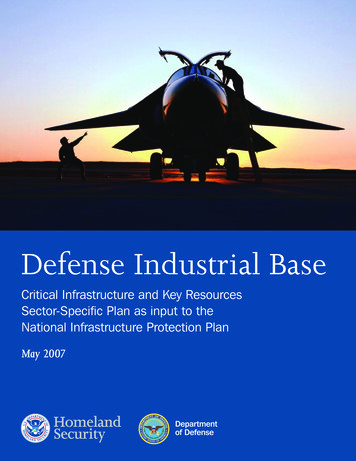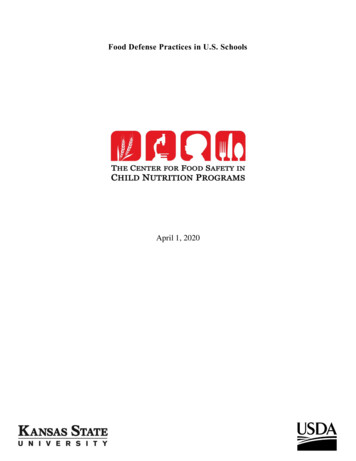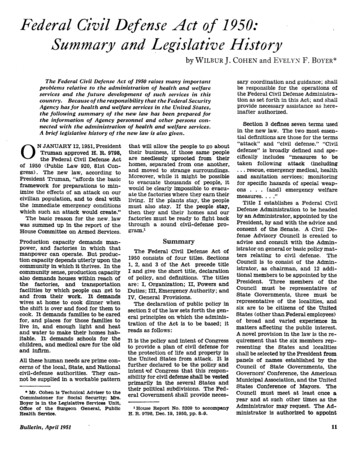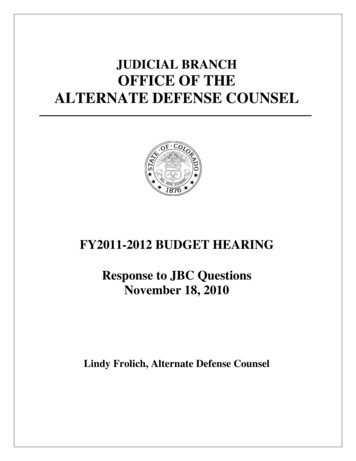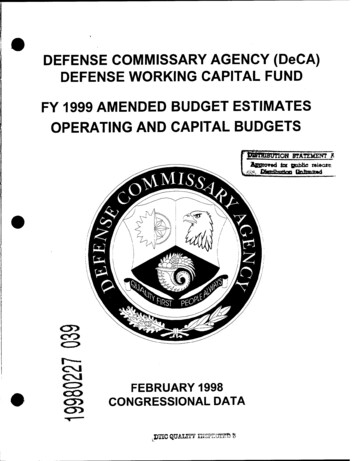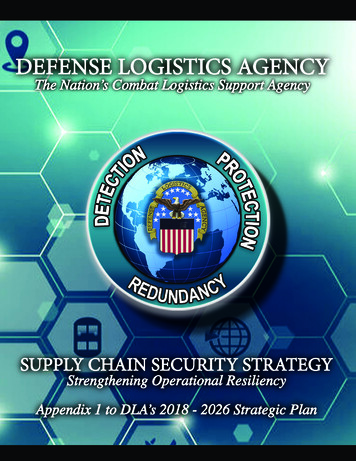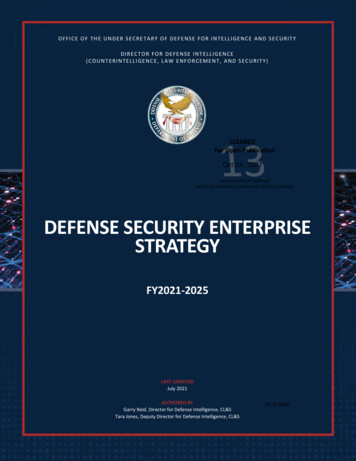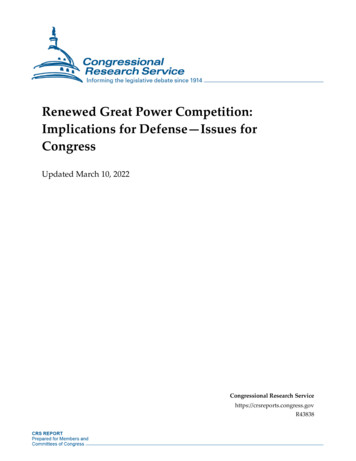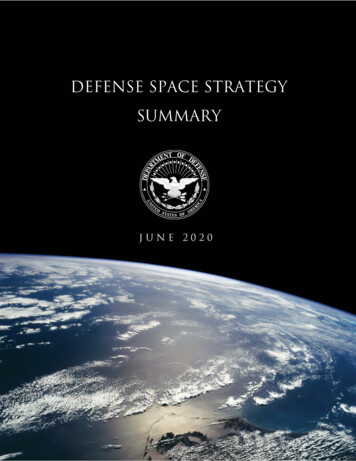
Transcription
DEFENSE SPACE STRATEGYSUMMARYJUNE 2020
Image courtesy of NASA
DEFENSE SPACE STRATEGYSUMMARYJUNE 2020
This page left intentionally blank
TABLE OF CONTENTSExecutive Summary . 1Desired Conditions. 2Strategic Context. 3Strategic Approach . 6Conclusion. 10
This page left intentionally blank
DEFENSE SPACE STRATEGYEXECUTIVE SUMMARYThe Department of Defense (DoD) is embarking on the most significant transformation inthe history of the U.S. national security space program. Space is now a distinct warfightingdomain, demanding enterprise-wide changes to policies, strategies, operations, investments,capabilities, and expertise for a new strategic environment. This strategy identifies howDoD will advance spacepower to enable the Department to compete, deter, and win in acomplex security environment characterized by great power competition.Space is vital to our Nation’s security, prosperity, and scientific achievement. Space-basedcapabilities are integral to modern life in the United States and around the world and are anindispensable component of U.S. military power. Ensuring the availability of thesecapabilities is fundamental to establishing and maintaining military superiority across alldomains and to advancing U.S. and global security and economic prosperity. Space,however, is not a sanctuary from attack and space systems are potential targets at all levelsof conflict. In particular, China and Russia present the greatest strategic threat due to theirdevelopment, testing, and deployment of counterspace capabilities and their associatedmilitary doctrine for employment in conflict extending to space. China and Russia each haveweaponized space as a means to reduce U.S. and allied military effectiveness and challengeour freedom of operation in space.Rapid increases in commercial and international space activities worldwide add to thecomplexity of the space environment. Commercial space activities provide national andhomeland security benefits with new technologies and services and create new economicopportunities in established and emerging markets. The same activities, however, also createchallenges in protecting critical technology, ensuring operational security, and maintainingstrategic advantages. Internationally, allies and partners also recognize the benefits of spacefor military operations, and increasingly understand the threats to those space activities.Allies and partners who are actively expanding their defense space programs, present novelopportunities to increase defense collaboration and cooperation.In response to this new security environment, and in accordance with the 2018 NationalStrategy for Space (NSfS) and the 2018 National Defense Strategy (NDS), this DefenseSpace Strategy (DSS) provides guidance to DoD for achieving desired conditions in spaceover the next 10 years. The DoD desires a secure, stable, and accessible space domain,whose use by the United States and our allies and partners is underpinned by comprehensive,sustained military strength. The strategy includes a phased approach for the defenseenterprise to move with purpose and speed across four lines of effort (LOEs): (1) build acomprehensive military advantage in space; (2) integrate space into national, joint, andcombined operations; (3) shape the strategic environment; and (4) cooperate with allies,partners, industry, and other U.S. Government departments and agencies.The Department is taking innovative and bold actions to ensure space superiority and tosecure the Nation’s vital interests in space now and in the future. Establishing the U.S.Space Force (USSF) as the newest branch of our Armed Forces and the U.S. SpaceCommand (USSPACECOM) as a unified combatant command, as well as undertakingsignificant space acquisition reform across the DoD, has set a strategic path to expandspacepower for the Nation. It is a path that embraces space as a unique domain of nationalmilitary power that, together with the other domains, underpins multi-domain joint andcombined military operations to advance national security.1
DEFENSE SPACE STRATEGYDESIRED CONDITIONSThis Defense Space Strategy (DSS) is designed to achieve the following desired conditionsat an accelerated pace over the next 10 years, focusing on the military application ofspacepower through control, exploitation, and influence of space to achieve strategic,operational, and tactical objectives.DESIRED CONDITIONS:The space domain is secure, stable, and accessible. The use of space by the UnitedStates and our allies and partners is underpinned by sustained, comprehensive U.S.military strength. The United States is able to leverage our use of space to generate,project, and employ power across all domains throughout the spectrum of conflict.To achieve these desired conditions, DoD will advance spacepower through the pursuit ofthe following defense objectives:Maintain Space Superiority: DoD will establish, maintain, and preserve U.S. freedom ofoperations in the space domain. DoD will be prepared to protect and defend U.S. and, asdirected, allied, partner, and commercial space capabilities and to deter and defeat adversaryhostile use of space.Provide Space Support to National, Joint,and Combined Operations: DoD spaceforces will deliver advanced space capabilitiesand effects to enable national, joint, andcombined operations in any domain throughsustained, comprehensive space militaryadvantages. DoD will leverage and bolster athriving domestic civil and commercial spaceindustry.Ensure Space Stability: In cooperation withallies and partners, DoD will maintainpersistent presence in space in order to: deter aggression in space; provide for safe transitin, to, and through space; uphold internationally accepted standards of responsible behavioras a good steward of space; and support U.S. leadership in space traffic management andthe long-term sustainability of outer space activities.SPACEPOWER:The sum of a nation’s capabilities to leverage space for diplomatic, information,military, and economic activities in peace or war in order to attain nationalobjectives.2
DEFENSE SPACE STRATEGYSTRATEGIC CONTEXTGreat power competition defines the strategic environment. Space is both a source of andconduit for national power, prosperity, and prestige. As a result, space is a domain that hasreemerged as a central arena of great power competition, primarily with China and Russia.CENTRAL PROBLEM:The U.S. defense space enterprise was not built for the current strategic environment.The intentions and advancements of potential adversaries in space are threatening theability of the United States to deter aggression, to protect U.S. national interests, and tofight and win future conflicts.More than any other nation, the United States relieson space-based capabilities to project and employpower on a global scale. Today, U.S. reliance onspace has increased to the point where spacecapabilities not only enhance, but enable our way oflife and way of war. U.S. national security andprosperity require unfettered access to and freedomto operate in the space domain.The reemergence of great power competition and arapid expansion of allied, partner, and commercialactivities in space in recent years have drasticallychanged the character of the space domain. The actions, intentions, and military strategiesof potential adversaries have transformed space into a warfighting domain. In parallel,growth in allied, partner, and commercial space capabilities has added complexity to thespace operating environment while creating an unprecedented level of collaborativeopportunities.These factors amplify the need to strengthen the U.S. defense posture and present severalthreats, challenges, and opportunities as the Department seeks to attain its desiredconditions.THREATS, CHALLENGES, AND OPPORTUNITIESThreats: China and Russia present the most immediate and serious threats to U.S. spaceoperations, although threats from North Korea and Iran are also growing. Chinese andRussian strategic intentions and capabilities present urgent and enduring threats to the abilityof the Department to achieve its desired conditions in space. China and Russia haveanalyzed U.S. dependencies on space and have developed doctrine, organizations, andcapabilities specifically designed to contest or deny U.S. access to and operations in thedomain. Concurrently, their use of space is expanding significantly. Both countries considerspace access and denial as critical components of their national and military strategies.Specifically, Chinese and Russian military doctrines indicate that they view space asimportant to modern warfare and consider the use of counterspace capabilities as a meansfor reducing U.S., allied, and partner military effectiveness and for winning future wars.China and Russia have weaponized space as a way to deter and counter a possible U.S.intervention during a regional military conflict.3
DEFENSE SPACE STRATEGYChallenges: Several factors may limit DoD’s ability to achieve its desired conditions: The DoD will continue to depend on space to project power and to respond rapidlyto crises worldwide to a greater extent than potential adversaries operating in theirrespective regions. The DoD has limited operational experience with conflict beginning in orextending into space, despite rapid counterspace advancements by potentialadversaries. Internationalunderstanding and agreement of what constitutes unsafe,irresponsible, or threatening behavior in space is nascent. U.S. activities, both terrestrial and in space, are increasingly exposed by advancesin potential adversary, rest-of-world, and commercial space-based capabilities,impeding the U.S. military’s freedom of maneuver and action in all domains.Meanwhile, potential adversaries are leveraging technological advancements in thecommercial space sector at decreased costs and broader accessibility to expandtheir space technologies and capabilities. Public understanding of their reliance on space systems, the changing character ofthe space domain, and the significantly growing counterspace threats to the UnitedStates and its allies and partners remains cursory.COUNTERSPACE CONTINUUMOpportunities: The emerging strategic environment also presents numerous opportunitiesthat may enhance the Department’s ability to attain its desired conditions: National leadership recognizes the criticality of space to national security andprosperity. Space, including space security, is a top national priority with increasingresources to ensure continued U.S. leadership in this critical domain. Strategicguidance, including the National Security Strategy, the NDS, and the NSfSunderscore the Nation’s vital interest of unfettered access to, and freedom tooperate in, space.4
DEFENSE SPACE STRATEGY The creation of new space-focused organizations in DoD offers an historicopportunity to reform every aspect of our defense space enterprise. The USSF,the newest branch of the Armed Forces, will bring unity, focus, and advocacy toorganizing, training, and equipping space forces. USSPACECOM, the newestcombatant command, will bring additionaloperational focus to deterring threats and shapingthe security environment in space. Concurrent withongoing space acquisition activities within theDepartment of the Air Force, the SpaceDevelopment Agency was established under a newmodel for rapid acquisition to rapidly develop andfield new space capabilities. Taken together, zes the commitment of both thelegislative and executive branches of government to champion strategic changeacross the national security space enterprise. These new institutions bring focusand momentum to addressing current and future challenges. New leadership and management for space acquisition has been established tounify the Department’s space acquisition efforts into a streamlined structure forbetter integration and speed of delivery. A new Assistant Secretary of the Air Forcefor Space Acquisition and Integration ASAF(A&I), along with a new Space ForceAcquisition Council (SFAC), will simplify the leadership and synchronization ofthe DoD’s space development efforts by overseeing and directing: the SpaceDevelopment Agency, the Space and Missile Systems Center, and the Space RapidCapabilities Office. When the transfer of the Space Development Agency iscompleted, the Department will have a new unified structure. The United States has long maintained a robust and prolific arrangement ofalliances and partnerships built on trust, common values, and shared nationalinterests. This approach creates an important advantage for the United States andits allies and partners. Many U.S. allies and partners acknowledge space as anintegral component of their respective national security strategies and recognizethe increasing counterspace threats posed by potential adversaries. As a result,they are increasingly interested in collaborating in the development of spacecapabilities, sharing space-related information and intelligence, and partnering inspace operations to secure access to, and ensure freedom of action in, space. Commercial space activities have expanded significantly in both volume anddiversity, resulting in new forms of commercial capabilities and services thatleverage commoditized, off-the-shelf technologies and lower barriers for marketentry. These developments are contributing to a burgeoning space industry drivenby entrepreneurial innovation and investment, advanced technology, decreasedcosts, and increased demand for space-based services. The DoD has anopportunity to leverage innovation and cost-effective investments driven by theprivate sector, presenting opportunities for collaboration to develop gamechanging capabilities with a more streamlined and responsive acquisition process.5
DEFENSE SPACE STRATEGYSTRATEGIC APPROACHThe Department is rapidly transforming its approach to space from a support function to awarfighting domain in order to achieve our desired conditions and strategic objectives overthe next 10 years in the face of identified threats, challenges, and opportunities.CENTRAL IDEA:The Department will grow its spacepower capacity over the next 10 years to ensurespace superiority and secure the Nation’s vital interests. The Department will take actionrapidly to leverage opportunities and U.S. strengths in close cooperation with our allies,partners, and industry.Generating an enduring superior spacepowercapacity will take a number of years and willrequire DoD to rely in the near-term onenhancing existing capabilities.TheDepartment will expand its space partnershipsand will establish new and deeper pathways tocollaborate with allies, partners, industry, andother U.S. Government departments andagencies,makingcooperationandcollaboration a matter of course in futurecapability development and operations. Theseactions will be undertaken while theDepartment builds comprehensive militaryspacepower through a trained and ready forcethat is integrated into Joint Force plans tosupport the Department’s objectives to compete, deter, and win across the spectrum ofconflict. This will require embracing space as a unique domain of national and militarypower while also embracing principles of joint warfare.The Department will pursue the following prioritized lines of effort (LOEs) to achieveour desired conditions while addressing identified threats, opportunities, and challenges:1) Build a comprehensive military advantage in space.2) Integrate military spacepower into national, joint, and combinedoperations.3) Shape the strategic environment.4) Cooperate with allies, partners, industry, and other U.S. Governmentdepartments and agencies.6
DEFENSE SPACE STRATEGYLOE 1: Build a comprehensive military advantage in space. The Department musttransform its space enterprise by: reforming its organizations; fielding resilient architectures;building capabilities to counter hostile uses of space; and developing spacepower ate with the threat. DoD willdevelop an agile space enterprise that can takeadvantage of emerging technological andcommercial innovation in order to continuallyoutpace adversary threats. Space superioritywill be achieved through on-orbit, multidomain, and cross-component operations thatare fully integrated with our allies and partners.The establishment of the USSF as a newbranch of the Armed Forces offers a historicand immediate opportunity to rapidlytransform the enterprise to achieve spacesuperiority.Additionally, the creation of anew ASAF (A&I) and SFAC will further unifyDoD space acquisition efforts, improving the synchronization of space systems andprograms and ensuring integration across the national security space enterprise. DoDcomponents will prioritize necessary resources for this LOE for the duration of the DSStimeframe. Specific objectives include: Build out the U.S. Space Force. Develop and document doctrinal foundations of military spacepower. Develop and expand space warfighting expertise and culture. Field assured space capabilities. Develop and field capabilities that counter hostile use of space. Improve intelligence and command and control (C2) capabilities that enablemilitary advantage in the space domain.LOE 2: Integrate military spacepower into national, joint, and combined operations.Military spacepower achieves its greatest potential when combined with all other forms ofmilitary power. The integration of superior space capabilities into and throughout the JointForce, along with operational integration with allies and partners, is essential for securingour military advantage against threats in space. As DoD builds superior space forces, it mustfurther develop and enhance integration of space warfighting doctrine, capabilities, andpersonnel into national, joint, and combined operations. The establishment ofUSSPACECOM as a new combatant command provides a full-time operational focus ondeterrence, integration, and employment of military spacepower. DoD components willprioritize necessary resources for this LOE for the duration of the DSS timeframe. Specificobjectives include:7
DEFENSE SPACE STRATEGY Enable USSPACECOM to plan, exercise, and execute joint and combined spaceoperations across the spectrum of conflict. Realign operational authorities and update rules of engagement. Integrate space warfighting operations, intelligence, capabilities, and personnel intomilitary plans and staffs. Update security classification for DoD space programs. Integrate allies and partners into plans, operations, exercises, engagements, andintelligence activities.LOE 3: Shape the strategic environment. DoD will deter aggression and attacks in spaceand, if deterrence fails, be capable of winning wars that extend into space. Additionally, DoDwill take actions that enhance domain stability and reduce the potential for miscalculations.In this context, international views about space as a warfighting domain and what constitutesacceptable and unacceptable behavior in that domain are nascent or, in some cases, nonexistent.DoD will partner with theDepartment of State (DoS) to work closelywith allies and partners in order to developcommon understandings of appropriatebehavior in space. The United States must alignwith allies and partners to engage proactivelyand assertively with the wider saries, to advance U.S., allied, and partnernational security interests and to reduce thepossibility of mishaps and misperceptions.This LOE must be executed in closecooperation with DoS and across all key DoDcomponents, utilizing appropriate authorities,without adversely affecting space capability development, production, and fielding activities.Overall, LOE 3 activities are enduring but critical in the near-term in order to leverage U.S.strengths as the Department develops space warfighting policy and builds associatedwarfighting capacity.Specific objectives include: Inform international and public audiences of growing adversarial threats in space. Deter adversary aggression against the space capabilities of the United States andits allies, partners, and commercial interests. Coordinate space messaging. Promote standards and norms of behavior in space favorable to U.S., allied, andpartner interests.8
DEFENSE SPACE STRATEGYLOE 4: Cooperate with allies, partners, industry, and other U.S. Governmentdepartments and agencies. Partnering is both inherent in the first three LOEs and adistinct LOE in its own right. In closepartnership with key U.S. departments andagencies, DoD must enhance spacecooperation with international partners andcommercial entities, many of whose spacecapabilities are already integral to collectivesecurity. DoD will promote burden-sharingwith our allies and partners, developing andleveraging cooperative opportunities in policy,strategy, capabilities, and operational realms.Pursuit of LOE 4 will be ongoing, with themost significant attention needed in the shortterm to lay foundations for benefits over thelong-term. Specific objectives include: Expand information sharing relationships with capable allies and partners. Align with allies and partners on space policy. Join with allies, partners, and other U.S. Government departments and agencies topromote favorable standards and norms of behavior in space. Expand cooperative research, development, and acquisition (RD&A) with alliesand partners. Leverage commercial technological advancements and acquisition processes. Modernize DoD’s approach to the commercial licensing approval process.9
DEFENSE SPACE STRATEGYCONCLUSIONThis strategy provides an opportunity to buildupon existing work by taking immediate andenduring steps to generate and employ a superiorspacepower capacity. Successful implementationof this strategy requires embracing space activitiesas a unique source of national and military powerand incorporating the principles of joint warfareinto space operations. Implementation of thestrategy will posture the Department to achieveits strategic objectives with the necessaryprioritization of resources and risk managementto advance U.S. national interests.10
This page left intentionally blank
2
Jun 17, 2020 · EXECUTIVE SUMMARY The Department of Defense (DoD) is embarking on the most significant transformation in the history of the U.S. national security space program. Space is now a distinct warfighting domain, demanding enterprise -wide changes to policies, strategies, operations, investm
